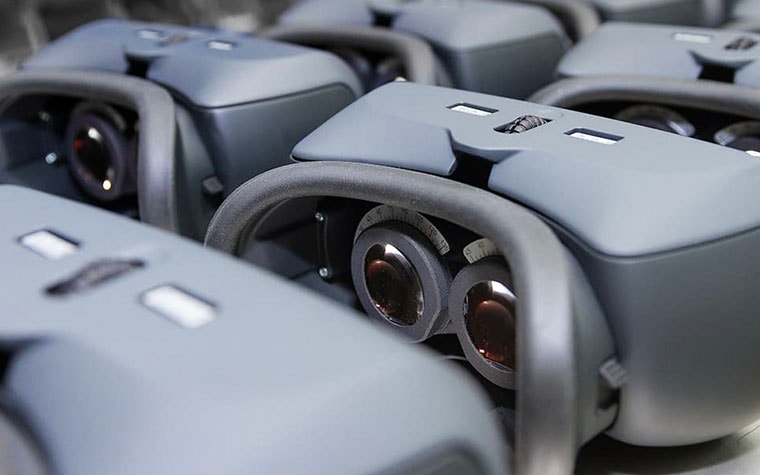TRENDS
Sustainability, Scaling, and Uncertainty: 3D Printing Trends for 2020

In 2020, we will celebrate Materialise’s 30th anniversary. In the past three decades, we’ve seen 3D printing grow from a nascent technology that was struggling to create even basic shapes to a revolutionary technology capable of transforming entire industries and challenging our traditional manufacturing processes. We build on those three decades of 3D printing experience to look forward and identify those themes and trends that will drive and define our industry in 2020.
1. Making 3D printing more sustainable
Multinational corporations are becoming increasingly influential, and with that influence comes responsibility. The 3D printing industry is not exempt from this and needs to consider the social and environmental impact of the technology. This means that, as we develop new products and technologies to help our customers create innovative and meaningful applications, sustainability needs to become top of mind.
3D printing already affords companies with an instrument to manufacture in a more sustainable way — both socially and environmentally. The technology empowers people locally through decentralized production, improves people’s health and well-being through personalized care, and enables higher-quality jobs. At the same time, 3D printing also supports a manufacturing process with less waste through mass customization and optimized distribution. As a result, many view 3D printing as a positive force that helps companies operate more sustainably. But that is simply not enough.
"Our industry can and needs to do more by developing new and innovative ways to reduce our impact on the societies we interact with and the environments we operate in,” says Fried Vancraen, Founder and CEO. “I’m excited to see more and more industry leaders who recognize this and who develop initiatives to reduce energy consumption, to increase usage of recycled powder, and to create the workplaces of the future."
Moving forward, the question is not: is 3D printing a more sustainable manufacturing technology? The question becomes: what can we do to make 3D printing more sustainable?
2. Uncertainty becomes opportunity
With uncertain economic times ahead of us, manufacturers will focus more on reducing costs and mitigating risks, particularly those manufacturers operating in industries that are more sensitive to fluctuating demand. During the economic crisis of the late 2000s, the 3D printing industry was hit quite hard, seeing as it mainly served as a prototyping technology at the time. And as companies cut investments in R&D, the demand for prototyping fell.
“Today, this is different,” says Jurgen Laudus, Vice President and General Manager of Materialise Manufacturing. “3D printing is no longer only about prototyping — it has become a complementary technology for the creation of final products. At the same time, the technology itself has matured, and with increased trust, more manufacturers now rely on 3D printing to deliver specific design and manufacturing benefits. And so in uncertain times, 3D printing no longer represents a cost and a risk — but an opportunity.”


Compared to traditional manufacturing technologies, 3D printing doesn’t follow the same economies of scale. It requires very little start-up capital. On-demand production means there is less need for stock, and localized production can absorb the impact of fluctuating tariffs.
As we face uncertain economic times, we believe more manufacturers will turn to 3D printing as a tool to reduce costs and mitigate risks.
3. Laying the foundations for AI in AM
Data is power. With the increased adoption of 3D printing and more sensors providing improved insight into the 3D printing build process, we are collecting more data than ever.
But collecting data is not enough — we need to make data actionable.
AI is a promising and incredibly powerful tool to digest large datasets and create actionable insights. But this requires not only large data sets but also a deep understanding of processes. Or, in this case: the 3D printing build process.
“Today, there are certainly instances where AI helps to advance 3D printing,” says Stefaan Motte, Vice President and General Manager of Materialise Software. “But before we can truly adopt AI in AM, we need to work on developing better insights and get a better understanding of the many parameters and algorithms that define the 3D printing process. This will require continued investments in research and innovation and cross-industry collaboration.”
Only when we truly understand the 3D printing process and develop actionable insights on how to make this process faster, more stable, and more predictable can we unleash the full potential of AI in AM.
4. A new climate of innovation
In recent years, 3D printing has advanced on many fronts: faster machines, new materials, and more finishing options. Today, we see all of these advances coming together to create an exciting new climate of innovation.
“This is excellent news for the 3D printing industry,” says Kristel Van den Bergh, Director of Innovation. “Not only because it allows us to enhance existing applications with improved production processes, but it also sparks the development of entirely new applications that were unthinkable or unachievable before.”
A good example is the new TPU material for mass customization. In previous years, it was possible to print with TPU, but the process was rather unstable and, therefore, unscaleable. Now HP’s MJF machines, BASF’s new TPU materials, and Materialise’s knowledge of process and design are the perfect mix to create and scale new applications such as footwear, athletic gear, and safety equipment.
Advances in 3D printing machines, software, and materials are creating a perfect storm of opportunities. In previous years, consumers may not have known or cared about the manufacturing process behind their product of choice. Now, with increased performance, aesthetics, and active participation in the personalization process, 3D printing is about to get real. In 2020 and beyond, people will discover and enjoy products they never imagined before.
5. Investing in automated post-processing
As companies scale their 3D printing operations, they increasingly rely on automation. But the potential to scale is limited by post-processing, which today is still mostly a manual process. Scaling this manual process by simply adding people increases cost and variability but doesn’t increase reliability. If we want to scale production, the only way forward is to automate post-processing.
This is especially the case for mass customization. For personalized footwear, different customers may want different colors, which complicates the process even more. And even if we talk about mass customization, the total output is still relatively small.
“We believe that the time for automating post-processing is now,” says Bart Van der Schueren, CTO. “At Materialise, we’ve been heavily investing in these processes. An example of our recent commitment to automation is that we robotized our entire cleaning line in our medical production to ensure the highest possible quality standards.”


Fortunately, Industry 4.0, with its increased automation capabilities and robotics, is creating new ways to automate the post-processing steps. This will require time, effort, and new investments that will only pay off if 3D printing starts to scale. Which it will. And that’s why it’s vital to invest in automated post-processing today.
3D printing in 2020
“If we could go into 2020 with only one word in mind, it would be ‘sustainability.’ The focus on sustainability will go beyond environmental and social impact. Though there are uncertain economic times ahead, 3D printing presents an opportunity for companies to be financially sustainable, through end-use production and new applications, along with technical capabilities like automated post-processing and AI. These trends will define our industry in 2020.”
— Fried Vancraen, Materialise CEO
Share on:
You might also like
Never miss a story like this. Get curated content delivered straight to your inbox.
